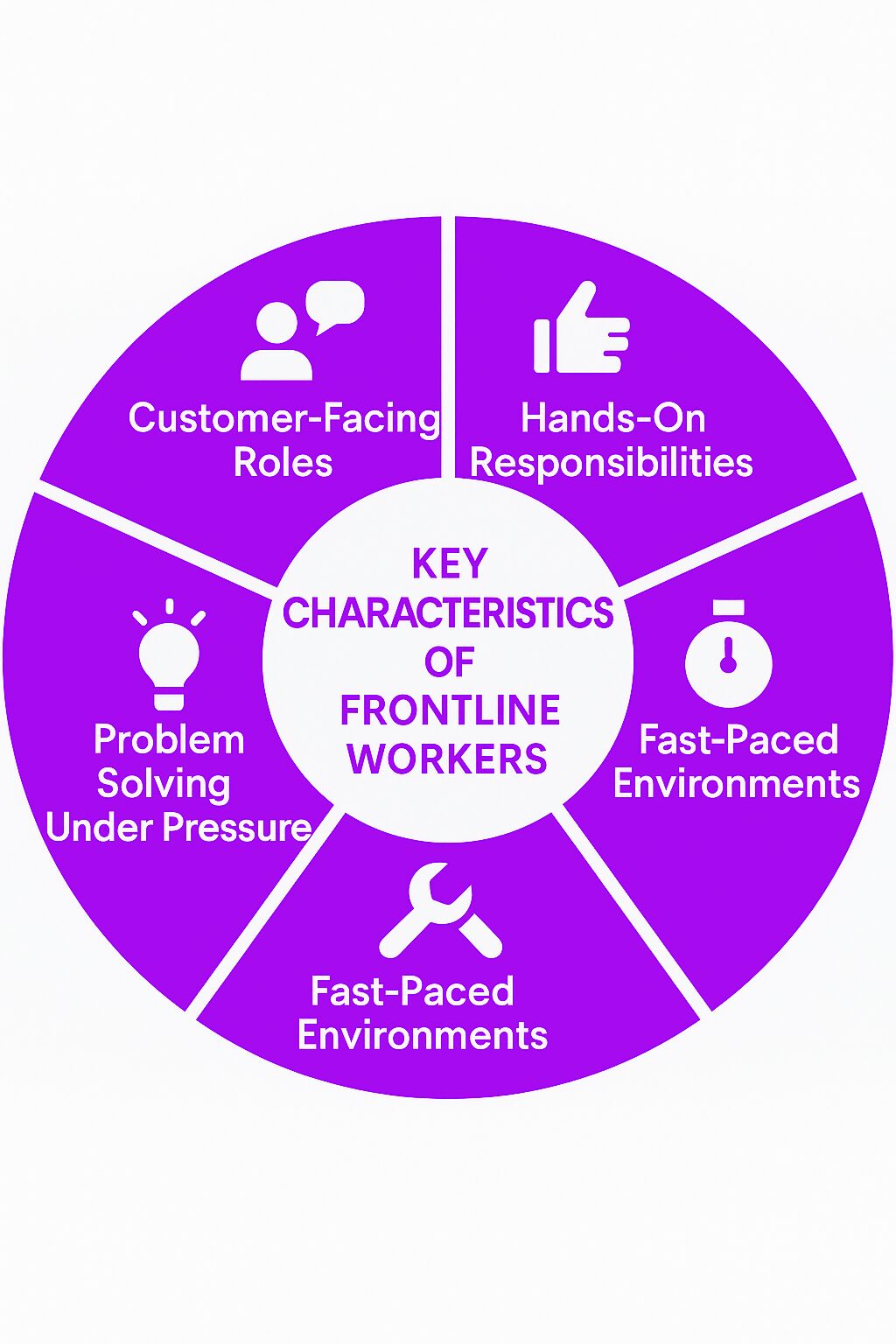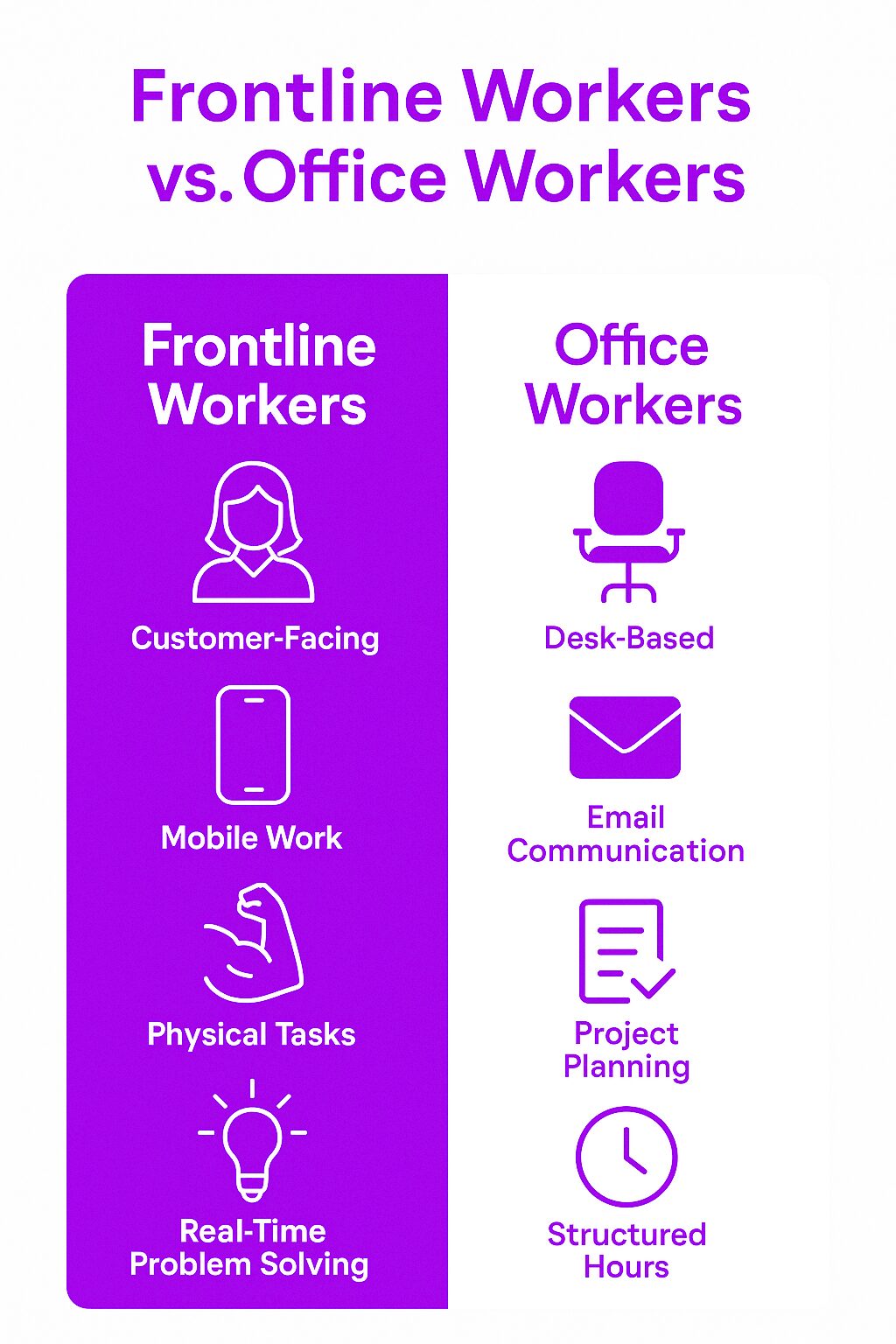What is a Frontline Worker?
A frontline worker is an employee who directly interacts with customers, clients, or critical operations within a business. These workers are the face of an organization, ensuring services run smoothly, products reach customers, and essential functions continue without interruption. Unlike office-based employees who primarily work behind the scenes, frontline workers operate in customer-facing, service-oriented, or operational roles that require immediate decision-making and problem-solving.
Essential workers, especially during the COVID-19 pandemic, played critical roles in maintaining societal function. It is necessary to provide them with safe working conditions and fair wages to acknowledge their contributions.
Frontline workers are essential in industries such as healthcare, retail, hospitality, transportation, manufacturing, and public services. They include roles like nurses, store associates, factory workers, delivery drivers, and emergency responders. Their work is often fast-paced, physically demanding, and critical to daily operations.
Why Frontline Workers Matter
Frontline workers form the backbone of many industries. Their contributions ensure businesses operate efficiently, customers receive quality service, and essential services remain accessible. Despite their importance, frontline employees often face unique challenges, such as limited access to company communication tools, high workloads, and job-related stress.
It is crucial to support frontline workers by recognizing the unique challenges they face and empowering them in their roles.
Investing in frontline worker engagement improves productivity, reduces turnover, and enhances customer experiences. Companies that prioritize training, communication, and well-being initiatives for their frontline teams see higher job satisfaction and stronger brand loyalty.
Key Characteristics of Frontline Workers
1. Customer-Facing Roles
Frontline workers directly serve customers, whether in retail stores, restaurants, hospitals, or service centers. Their communication skills and ability to handle challenges shape the customer experience.
2. Hands-On Responsibilities
Unlike desk-based employees, frontline workers perform tasks that require physical activity, problem-solving, and adaptability. Technology, particularly mobile applications, is essential for task management and optimizing frontline operations. This includes stocking inventory, assembling products, operating machinery, and delivering services.
3. Fast-Paced Work Environments
Frontline employees often work in high-pressure environments where quick thinking and efficiency are crucial. Healthcare workers respond to emergencies, retail workers manage peak shopping hours, and warehouse workers meet shipping deadlines.
4. Limited Access to Traditional Office Tools
Many frontline workers do not have company email addresses, desktop computers, or daily access to internal communication channels. This makes workplace communication and training more challenging.
Types of Frontline Jobs
Frontline jobs encompass a wide range of roles across various industries, including healthcare, retail, manufacturing, and more. These jobs typically involve direct interaction with customers, clients, or patients, and are often characterized by a high level of physical and emotional demands. Some common types of frontline jobs include:
-
Customer Service Representatives: These employees handle customer inquiries, complaints, and provide information about products and services.
-
Sales Associates: Found in retail environments, they assist customers with purchases, provide product information, and ensure a pleasant shopping experience.
-
Bank Tellers: They manage financial transactions, assist with account inquiries, and provide customer service in banking institutions.
-
Healthcare Professionals: This category includes nurses, doctors, and medical assistants who provide essential medical care and support to patients.
-
Retail Workers: Roles such as cashiers, stockers, and sales reps are crucial in maintaining store operations and customer satisfaction.
-
Manufacturing and Production Line Workers: These employees are involved in the creation and assembly of products, ensuring quality and efficiency.
-
Construction and Contracting Workers: Carpenters, electricians, and plumbers work on building sites, contributing to infrastructure development.
-
Food and Beverage Workers: Servers, bartenders, chefs, and kitchen staff ensure the smooth operation of dining establishments.
Industries with Frontline Workers
Frontline workers can be found in a variety of industries, each playing a crucial role in maintaining essential services and operations. Some of the key industries include:
-
Healthcare: Hospitals, clinics, nursing homes, and medical offices rely on frontline workers to provide patient care and support.
-
Retail: Department stores, grocery stores, restaurants, and convenience stores depend on frontline employees to assist customers and manage daily operations.
-
Manufacturing: Production lines, warehouses, and factories require frontline workers to assemble products, manage inventory, and ensure quality control.
-
Construction and Contracting: Building sites, construction companies, and contracting firms employ frontline workers to carry out essential construction tasks.
-
Food and Beverage: Restaurants, cafes, bars, and food trucks rely on frontline workers to prepare and serve food, ensuring customer satisfaction.
-
Transportation: Airlines, airports, bus and train stations, and taxi and ride-sharing services depend on frontline workers to manage logistics and provide customer service.
-
Financial Services: Banks, credit unions, insurance companies, and financial institutions employ frontline workers to handle transactions and assist customers.
Key Stages and Components of Frontline Work
Recruitment and Onboarding
-
Hiring processes focus on customer service skills, adaptability, and job-specific competencies.
-
Onboarding includes hands-on training, safety procedures, and company culture education.
Daily Responsibilities
-
Serving customers, processing transactions, handling logistics, or performing specialized tasks.
-
Adapting to real-time issues such as product shortages, customer complaints, or operational disruptions.
Training and Skill Development
-
Continuous learning is essential for safety, compliance, and job efficiency.
-
Professional development is crucial in enhancing job satisfaction and performance among frontline workers.
-
Mobile-based training and hands-on learning methods are commonly used due to limited desk access.
Performance Management and Recognition
-
Regular feedback, performance reviews, and incentive programs help maintain motivation.
-
Peer recognition and leadership acknowledgment improve morale.
Benefits of Frontline Workers
For Businesses
-
Customer Loyalty: A well-trained frontline workforce enhances customer service and satisfaction.
-
Operational Efficiency: Reliable frontline employees ensure smooth day-to-day operations.
-
Competitive Advantage: Engaged frontline teams differentiate a brand from competitors.
For Employees
-
Job Stability: Frontline roles are essential, offering steady employment opportunities.
-
Skill Growth: Hands-on experience fosters valuable problem-solving and communication skills.
-
Career Progression: Many frontline roles serve as stepping stones to leadership positions. Tailored training, support, and a conducive work environment can significantly enhance job satisfaction among frontline workers.
Challenges Faced by Frontline Workers
1. Workplace Stress and Burnout
High-pressure environments, long shifts, and demanding workloads contribute to stress. Limited breaks and repetitive tasks can lead to physical and mental fatigue.
2. Limited Internal Communication
Frontline employees often lack access to company announcements, email updates, and corporate messaging. This disconnect can lead to miscommunication, decreased engagement, and a lack of awareness of company policies.
3. High Turnover Rates
Due to physically demanding work and limited career growth opportunities, frontline positions often experience high employee turnover, leading to recruitment and training challenges.
Safety and Health Risks for Essential Workers
Jobs in healthcare, manufacturing, and food service expose workers to occupational hazards, such as workplace injuries, exposure to diseases, and demanding physical conditions.
Practical Tips and Best Practices for Supporting Frontline Workers
1. Improve Communication Channels
-
Use mobile apps, digital signage, or messaging platforms to share updates and company news.
-
Provide direct lines of communication between frontline employees and leadership.
2. Offer Meaningful Training Opportunities
-
Implement microlearning modules that fit into workers’ schedules.
-
Provide training on customer service, conflict resolution, and technical skills.
3. Recognize and Reward Contributions
-
Establish employee recognition programs to celebrate achievements.
-
Empower frontline workers by recognizing their contributions and providing them with the necessary support and resources.
-
Offer performance-based incentives and career advancement opportunities.
4. Support Work-Life Balance
-
Ensure reasonable scheduling and adequate breaks to prevent burnout.
-
Provide mental health resources and wellness programs tailored to frontline needs.
5. Prioritize Workplace Safety
-
Enforce safety protocols and provide necessary protective gear.
-
Emphasize the critical role that frontline workers play in maintaining essential services, especially during crises, and the importance of improving their working conditions.
-
Offer training on handling emergencies and hazardous situations.
Frontline Operations and Management
Effective frontline operations and management are critical to the success of any organization. This involves several key components:
-
Clear Communication and Direction: Providing frontline workers with clear instructions and regular updates ensures they understand their roles and responsibilities.
-
Adequate Training and Support: Continuous training and support equip frontline workers with the skills and knowledge needed to perform their tasks efficiently.
-
Efficient Processes and Systems: Implementing streamlined processes and systems helps to enhance productivity and reduce operational bottlenecks.
-
Positive Work Environment: Fostering a supportive and inclusive work environment boosts morale and job satisfaction among frontline workers.
-
Employee Engagement and Empowerment: Encouraging frontline workers to take ownership of their tasks and involving them in decision-making processes enhances engagement and job satisfaction.
Frontline Managers and Leadership
Frontline managers and leaders play a crucial role in supporting and empowering frontline workers. Their responsibilities include:
-
Coaching and Feedback: Providing regular coaching and constructive feedback helps frontline workers improve their performance and develop their skills.
-
Open Communication: Encouraging open communication and actively listening to frontline workers’ concerns fosters a culture of trust and collaboration.
-
Recognition and Rewards: Acknowledging and rewarding the contributions of frontline workers boosts morale and motivation.
-
Continuous Improvement: Promoting a culture of continuous improvement and innovation encourages frontline workers to find better ways to perform their tasks.
-
Empowerment: Empowering frontline workers to make decisions and take ownership of their work enhances their sense of responsibility and job satisfaction.
Frontline Work and Customer Satisfaction
Frontline work has a direct impact on customer satisfaction and loyalty. Key aspects include:
-
Excellent Customer Service: Providing friendly, efficient, and helpful service ensures a positive customer experience.
-
Prompt Issue Resolution: Addressing customer issues quickly and effectively builds trust and satisfaction.
-
Positive Customer Experience: Creating a welcoming and pleasant environment encourages repeat business and customer loyalty.
-
Customer Feedback: Actively seeking and using customer feedback to improve frontline operations demonstrates a commitment to quality service.
-
Recognition of Contributions: Recognizing and rewarding frontline workers for their role in achieving high customer satisfaction reinforces the importance of their work.
By focusing on these areas, businesses can support their frontline workers, enhance customer satisfaction, and achieve long-term success.
Related Concepts
1. Frontline vs. Office Workers
-
Office workers primarily use digital tools and work in structured environments, while frontline workers interact directly with customers and operations.
2. Employee Engagement for Frontline Workers
-
Strategies like mobile communication tools, real-time feedback loops, and inclusive decision-making improve engagement.
3. Digital Transformation in Frontline Work
-
Businesses are increasingly adopting digital solutions such as mobile apps, AI-powered scheduling, and remote training tools to enhance frontline operations.
Real-World Examples of Frontline Worker Support Programs
Walmart’s Frontline Training App
Walmart launched a mobile-based training app that allows store associates to learn on the go, improving efficiency and engagement.
Starbucks’ Employee Recognition Program
Starbucks offers stock options and tuition assistance to its frontline workers, increasing retention and job satisfaction.
Amazon’s Safety Initiatives
Amazon invested in wearable technology to track warehouse worker movements and prevent injuries, enhancing workplace safety.
The Future of Frontline Work
As businesses evolve, frontline worker roles will continue to shift. Companies must embrace technology, training, and employee well-being initiatives to ensure frontline teams remain engaged, productive, and valued.
Investing in frontline workers is not just a business necessity—it’s a strategic advantage that strengthens customer relationships, enhances operational success, and builds a more resilient workforce.






